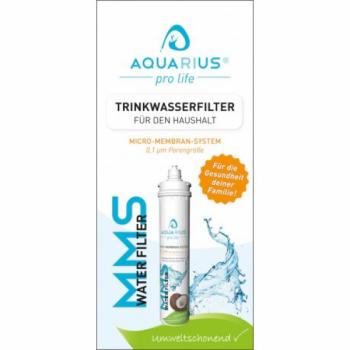1. Wird der Kalk vollständig herausgefiltert?
FAZIT: Unser Filter ist kein spezieller Kalk-Filter!
2. Wie ist der elektrische Leitwert des gefilterten Wassers?
Unseriöse Verkaufsaussagen
Häufig verwenden Anbieter von Osmose-Anlagen ein TDS-Messgerät, um Interessenten davon zu überzeugen, dass das eigene Leitungswasser krank macht. Es wird behauptet, mit dem Gerät würden die im Wasser befindlichen Schadstoffe gemessen. Ausschließlich Wasser mit sehr niedrigem Wert unter 100 µS sei gesundheitsfördernd. Der digitale Messwert sei somit ein Richtwert für die Qualität des Wassers. Der Messwert zeigt jedoch lediglich an, wie leitfähig das Wasser ist. Nur Osmose-Wasser hat einen niedrigen Leitwert. Das liegt ausschließlich daran, dass ein Osmose-Wasser keine bis wenig Minerale mehr beinhaltet und daher nicht mehr leitfähig ist. Mittlerweile haben einige Hersteller von Osmose-Anlagen erkannt, dass „leeres“ Wasser unangenehm schmeckt und nicht gesundheitsförderlich ist. Daher haben die meisten nun eine Remineralisierungs-Stufe eingebaut. Würde diese aber funktionieren, wäre der Leitwert ja wieder so hoch wie vorher.
Minerale sind wichtige Geschmacksträger
Mineralien gehören in natürliches Quellwasser und bilden seinen Charakter. Sie geben dem Wasser seinen typischen regionalbedingten Geschmack. Ob ein Wasser nun viele oder wenige Minerale enthält, hängt ausschließlich von der Region ab und ist kein Qualitätsmerkmal für dessen Güte. Es gibt charaktervollere Wässer und leichtere Wässer.
Was sagt die Deutsche Trinkwasserverordnung zum Leitwert?
In der weltweit sehr strengen Deutschen Trinkwasserverordnung (TrinkwV) wird der elektrische Leitwert nur in Zusammenhang mit der Korrosion der Leitungen erwähnt. Ist der Mineralgehalt zu hoch, kann zwischen edlen und unedlen Metallen in den Leitungen ein Strom fließen und diese rosten lassen.
Was sagt die WHO zum Leitwert?
Aussagen, dass Wasser mit hohem TDS-Wert ungesund ist, werden von der WHO nicht bestätigt. In den WHO Richtlinien (WHO/SDE/WSH/03.04/16, Total dissolved solids in Drinking-water, Background document for development of WHO Guidelines for Drinking-water Quality) wird zusammenfassend festgehalten, dass es keine verlässlichen Studien gibt, die den Zusammenhang des TDS-Werts und der gesundheitlichen Wirkung von Wasser bestätigen. Wasser mit zu niedrigem TDS-Wert wird häufig als geschmacklich unangenehm beschrieben und sei ebenso problematisch wie Wasser mit einem Wert oberhalb von 2.000 µS.
FAZIT: Der TDS-Leitwert in PPM oder Mikrosiemens µs kann KEINE Aussage darüber treffen, ob ein Wasser gesund ist oder nicht! Aus diesem Grunde geben wir keine Angaben zum Leitwert an.
3. Wie ist der pH-Wert des gefilterten Wassers?
Einfluss des pH-Wertes auf den menschlichen Körper
Unser Körper braucht ein präzise ausbalanciertes Wechselspiel aus Säuren und Basen um alle Stoffwechselprozesse effektiv zu steuern. Leider ist die moderne Ernährung sehr pH-sauer. Der pH-Wert von Cola beträgt z.B. 2-3. Der Ansatz basisches Wasser zu trinken, kam wohl ursprünglich aus Japan/Korea. Dort hat man das Kangan-Wasser erfunden und damit auch Krankheiten behandelt. Aber dennoch sollte man dies als zeitlich befristetes Therapeutikum sehen und nicht als alltägliches Trinkwasser. Außerdem sollte es nur zu bestimmten Zeiten getrunken werden. Basisches Wasser zu den Hauptmahlzeiten würde nämlich die für unsere Immunabwehr wichtige Magensäure neutralisieren. Dies würde erheblich unsere Verdauung schwächen. Es gibt daher bessere Möglichkeiten zu entsäuern wie z.B. über Atemtechniken, basische Bäder und die richtige Ernährung. Einige bekannte Heilquellen mögen zwar leicht basisches Wasser haben, aber das Leben hat sich mit all seiner Vielfalt nicht nur um diese Heilquellen erfolgreich ausgebreitet, sondern überall. Tatsache ist das die Natur bei ihren Trinkquellen keine so großen Extreme hat, sondern Wasser nahe dem neutralen pH-Wert häufig in der Natur vorkommt. Damit kommen Mensch, Tier und Pflanze seit Jahrhunderten bestens aus. Daher ist dieses für den alltäglichen Bedarf wohl eher die Lösung.
FAZIT: Unser Filter verändert NICHT den pH-Wert des gefilterten Wassers!
4. Wie ist der Mineralgehalt des gefilterten Wassers?
Sobald aber Wasser wieder auf die Erde trifft, ins Grundwasser geht und zum Teil nach vielen Jahren wieder aus einer Quelle fließt, hat es sich wieder deutlich mit Mineralien wie z.B. Calcium, Magnesium und Natrium angereichert. Dieses Wasser ist nun pH-neutraler und chemisch nicht mehr aggressiv. Es ist somit für uns bio-kompatibel. Viele Umkehrosmoseanlagen entfernen nahezu vollständig all diese guten Mineralien. Die drastische Reduzierung des oben erwähnten elektrischen Leitwertes ist meistens genau darauf zurückzuführen. Dann hatte man festgestellt, dass so stark entmineralisiertes Wasser den meisten Menschen nicht so gut bekommt. Viele Heilpraktiker, aber auch feinfühlige Menschen reden tatsächlich von „totem Wasser“ und „leerem Wasser“ nach so einem Verfahren. Deshalb haben moderne Umkehrosmoseanlagen am Ende der Reinigungskette nun auch eine sogenannte Remineralisierungsstufe. Doch würde diese tatsächlich funktionieren, hätte man fast dieselben Leitwerte wie vor dem Filtern. Das Remineralisieren funktioniert meistens nicht.
FAZIT: Unser Filter verändert NICHT den Mineralgehalt des gefilterten Wassers!
5. Wie ist die Struktur des gefilterten Wassers?
6. Kann man den Filter auch liegend einbauen?
7. Kann man den Filter an Niederdruckleitungen anschließen?
8. Kann man den Filter an den Warmwasseranschuss anschließen?
9. Kann man den Filter vor die Hausversorgung anschließen?
10. Kann man den Filter an einem privaten Brunnen anschließen?
FAZIT: Wir geben keine Gewähr für die Funktion und Standzeit bei Betrieb an privaten Brunnen!


.jpg)
.jpg)
.jpg)



.jpg)
.jpg)
.jpg)



.jpg)
.jpg)
.jpg)


